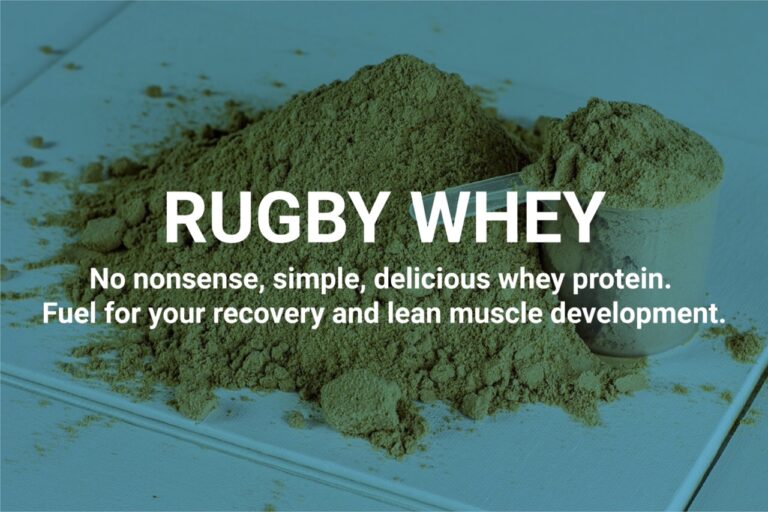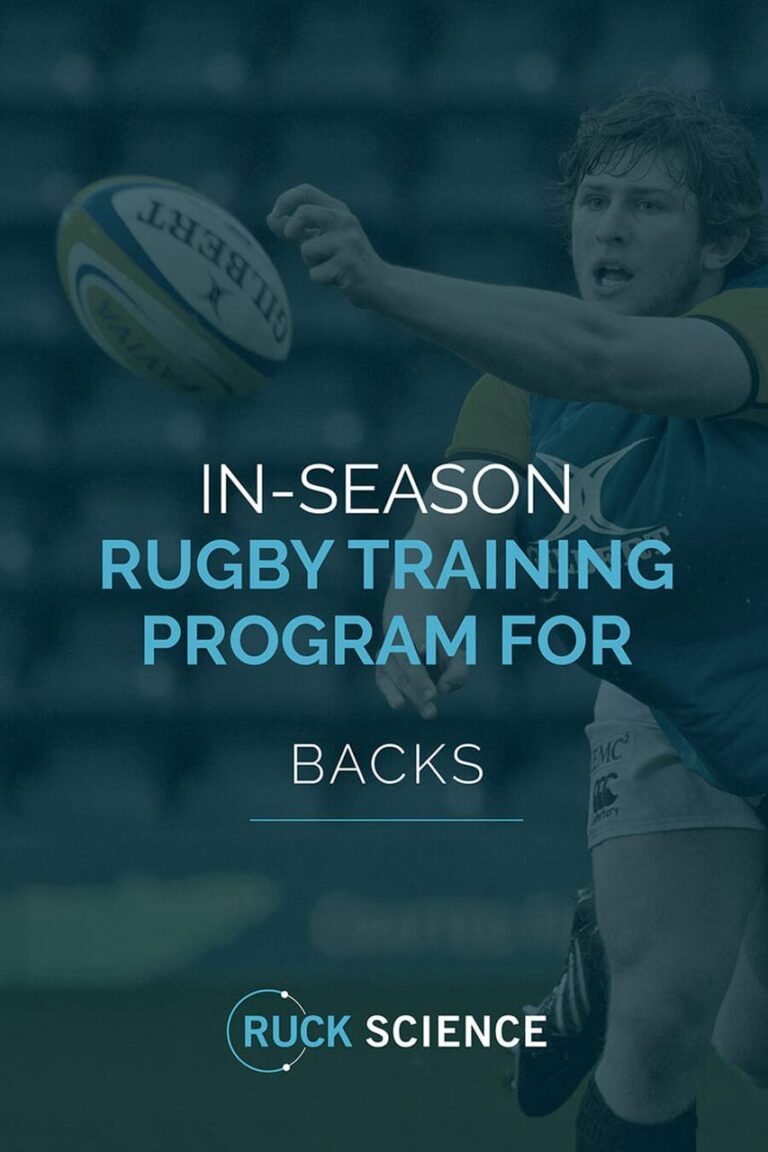French Contrast Training - Improving your Athleticism (Workout Guide Included)
Training for rugby can be very time-consuming. As well as developing a decent level of aerobic and anaerobic fitness, you need to be quick, agile, strong, and powerful, too. You’ll also need to find time to work on your mobility and flexibility and continue improving your rugby skills. These French contrast training methods will check most, if not all, of these boxes.

Being a well-rounded rugger is a full-time job!
And speaking of jobs, unless you are lucky (and talented) enough to be a professional player, you’ll need to balance the demands of rugby training with school, work, and family commitments.
Because of this, smart ruggers should always be on the lookout for time-efficient ways to train. Good examples of time-saving workout methods include:
• High-intensity interval training
• Sprint interval training
• Tabata training
• High-intensity strength training
• Circuit training
• Supersets and tri-sets
However, as effective as these training methods are, they only develop one or two components of rugby fitness. As such, you’ll still need to dedicate a lot of time to your training.
The good news is there is a training method that can help build strength, power, speed, agility, fitness, and muscle mass all at the same time – French Contrast Training, or FCT for short.
In this article, we explain why and how to do French Contrast Training and provide you with an FCT workout program to follow.
What is French Contrast Training
French Contrast Training was created by French track and field coach Giles Cometti. It is an advanced workout method designed to trigger muscular and neurological adaptations at the same time. It’s ideal for all athletes and is especially useful for time-pressed ruggers as workouts are intense but short and closely replicate the demands of rugby.
FCT workouts are built around two different training methods:
- Complex training: A strength exercise followed by a power exercise
- Contrast training: A heavy strength exercise followed by a light power exercise
But, rather than choose between these two methods, French Contrast training uses both, and exercises are grouped into fours, i.e.:
- Big compound strength movement, e.g., barbell back squat (80-90% 1RM)
- High force plyometric or speed movement, e.g., squat jumps
- Speed-strength movement, e.g., power clean (30% 1RM)
- Deloaded plyometric or speed movement, e.g., 10 to 15-meter sprint
Ideally, each exercise should affect the same muscles or involve similar movement patterns. The exercises are done back-to-back, which, as well as training the muscles and nervous system, will have a positive impact on cardiorespiratory fitness, too.
How French Contrast Training Works
FCT works by increasing the force of your muscle contractions through something called post-activation potentiation, or PAP for short. To better understand PAP, you must first understand how muscles work…
A muscle is made up of bundles of individual fibers. These muscle fibers are grouped into motor units, and each motor unit is controlled by a single motor nerve. Motor units either work at 100% of their contractile ability or do not work at all. This is called the all-or-nothing law.
To produce differing amounts of force, your body simply innervates (turns on) however many motor units it needs to achieve a specific task. So, if you need to lift a heavy weight, your body innervates a lot of motor units. But, if you only encounter light resistance, far fewer motor units are recruited.
Maximal force production is limited by how many motor units you can recruit. For example, untrained people can only recruit relatively low numbers of motor units, whereas trained individuals can recruit more. You can “learn” to innervate more motor units so you can generate more force.
While muscle fiber size plays a part in force production, so does nervous system engagement. That’s why it’s possible to be small and strong or big but weak; strength and power are neurological skills.
FCT increases something called post-activation potentiation, or PAP for short. PAP “tricks” your body into recruiting more motor units than usual. The heavy load primes your body for force generation, so, during the second exercise, more motor units are innervated.
In simple terms, the initial heavy exercise fires up your muscles, and they respond by recruiting more force in the following plyometric or speed exercise. This “wave” of heavy and light is repeated again during the second pair of movements, resulting in even greater force production.
Here’s an example of PAP in action:
Imagine you are loading boxes onto a truck. Each one looks identical but contains either bricks or pillows. The first few boxes contain bricks, and you have to work hard to lift each one.
Unknown to you, the next box contains only pillows, and you don’t just lift it but inadvertently launch it into the air. Your body was expecting a heavy load, but instead, the box weighed very little. As such, your muscles overcompensated and produced far more force than necessary.
Then, when the next box is heavy, you lift that one faster than usual because the light box primed your muscles to generate a lot of force quickly.
FCT works in much the same way, but this is no short-term trick. Studies show that by using this training method regularly, you will increase slow-speed strength and high-speed power simultaneously, which are two of the most crucial muscular fitness components in rugby (1).
French Contrast Training Workout Guide
Now you know what French Contract Training is and how it works, you should be chomping at the bit to try it for yourself.
And while there is nothing to stop you from writing your own FCT training plan, to save you trouble, we’ve created one for you.
But before you begin any of the following workouts, it’s important to stress that FCT is strenuous, and involves heavy weights and explosive movements, so you need to make sure you are well warmed up before you begin.
Start with five to ten minutes of light cardio, followed by dynamic mobility and flexibility exercises for all your major joints and muscles. Then, do a few progressively heavier sets of the exercises you’re about to do. These are called ramped sets and help acclimate your muscles to the weights you’re about to use.
For example, if you are planning on doing sets of five reps with 100 kilograms/220 pounds, your ramped sets could look something like this:
- 10 reps 20kg (empty barbell)
- 8 reps 40kg
- 5 reps 60kg
- 2 reps 80kg
- 5 reps 100kg (1st work set)
For this training plan, you will perform three workouts per week, e.g., Monday, Wednesday, and Friday. This leaves plenty of time for cardio training, mobility, and rugby practice. While FCT forms the backbone of each session, we’ve also included some additional strength training exercises to plug any developmental gaps that aren’t covered in the main workout.
Each workout ends with a “gut check” finisher. Think of this as extra time at the end of a rugby game. Dig deep and get it done!
Workout 1 – knee dominant + core
# | Exercise | Sets | Reps | Recovery |
1a | Back squat (80% 1RM) | 3-5 | 3-5 | 15-20 seconds between exercises, 3-5 minutes between laps |
1b | Tuck jump | |||
1c | DB squat jump (30% 1RM) | |||
1d | Jumping lunge | |||
2 | Seated calf raise | 2-3 | 8-12 | 60-90 seconds |
3 | Cable woodchop | 2-3 | 8-12 | 60-90 seconds |
4 | Hanging knee raise | 2-3 | 8-12 | 60-90 seconds |
Finisher: Row 2000 meters or run one mile as fast as possible.
Workout 2 – upper body
# | Exercise | Sets | Reps | Recovery |
1a | Bench press (80% 1RM) | 3-5 | 3-5 | 15-20 seconds between exercises, 3-5 minutes between laps |
1b | Plyo push-up | |||
1c | Push-press (30% 1RM) | |||
1d | Med ball push throw | |||
2 | Pull-ups/chin-up | 2-3 | Max | 60-90 seconds |
3 | Single-arm row | 2-3 | 8-12 | 60-90 seconds |
4 | Barbell curl | 2-3 | 8-12 | 60-90 seconds |
5 | Triceps dip | 2-3 | 8-12 | 60-90 seconds |
Finisher: 100 push-ups in as few sets as possible.
Workout 3 – hip dominant + core
# | Exercise | Sets | Reps | Recovery |
1a | Deadlift (80% 1RM) | 3-5 | 3-5 | 15-20 seconds between exercises, 3-5 minutes between laps |
1b | Broad jump | |||
1c | Power clean (30% 1RM) | |||
1d | 20-m sprint | |||
2 | Standing calf raise | 2-3 | 8-12 | 60-90 seconds |
2 | Ab wheel rollout | 2-3 | 8-12 | 60-90 seconds |
4 | Side plank | 2-3 | 30-60 seconds | 60-90 seconds |
Finisher: 100 burpees as fast as possible.
French Contrast Training Guidelines
Get the most from each and every FCT workout by following these guidelines:
1. This is not CrossFit!
While FCT workouts may look a little like a CrossFit conditioning workout, that’s not how they should be performed. Instead, the emphasis is on workout quality.
To that end, you should avoid training to failure on any of the exercises. Ideally, you should leave at least a couple of reps in the tank and end your set the moment you notice that you are starting to slow down.
Training adaptations are specific to the type of workout you do. Perform the reps quickly, and you’ll get faster. Grind them out, and you’ll get slower.
As well as stopping short of failure, you should also take 15-20 seconds between exercises to catch your breath. Don’t let cardiovascular fatigue limit your performance of the exercises. That said, don’t dawdle, either. Taking long breaks between exercises could reduce the amount of PAP you experience.
2. Go all-in on the power exercises
Just because you’re only doing 3-5 reps of plyo push-ups, jumping lunges, etc., doesn’t mean this is time to cruise and take it easy. Instead, make sure you go all-in on these exercises and do your best to generate as much force as possible.
The only way to make these exercises more challenging is to jump higher, push harder, etc., and not do more reps. So, make each rep an all-out effort, leaving nothing in the tank. But, remember to stop as soon as you notice any decreases in power output.
3. Don’t use FCT for too long without a deload
FCT is an effective way to build strength and power simultaneously, but it’s also very taxing. Because of this, it’s best to limit your use of FCT to 4 to 6-week blocks. Deload for a week with some less intense training and then return to FCT feeling refreshed and ready for more. Long periods of FCT could lead to injuries and overtraining. FCT is ideal for the off-season when you don’t have to try and balance training with playing.
4. Get acclimated to FCT with complex training
If you are new to this type of workout, ease yourself in gradually with a month or two of complex training. A complex is a strength exercise paired with a similar power exercise. This is still an effective and challenging training method but less taxing and more forgiving than full-on French Contrast Training.
Examples of complex training include:
- Deadlifts + kettlebell swings
- Pull-ups + medicine ball slams
- Bench press + plyo push-ups
- Squats + box jumps
5. Try wave loading
Because of post-activation potentiation, you should find that you get stronger as your FCT workout progresses. Make the most of this phenomenon by increasing your weights slightly from set to set.
For example:
Exercise | Set 1 | Set 2 | Set 3 | Set 4 |
Back squat | 80kg | 82.5kg | 85kg | 87.5kg |
Tuck jump* | Bodyweight | +2.5kg | +5kg | +7.5kg |
DB squat jump | 10kg | 12.5kg | 15kg | 17.5kg |
Jumping lunge* | Bodyweight | +2.5kg | +5kg | +7.5kg |
*Increase bodyweight by wearing a weighted vest or holding light dumbbells.
Don’t feel you have to increase your weights for every exercise and every set. Instead, base increases on how you feel. If your previous set went well, then increase the load. But, if you felt like you were already “in the zone,” you can leave the weights as they are.
6. Don’t forget to make your workouts progressive
You are only as strong and powerful as your last workout, and if you use the same weights or do the same number of reps every week, your progress will soon stall.
Avoid wasting your time and energy by making sure your workouts are progressive. While staying within the FCT parameters, increase your weights or reps weekly to ensure that you keep adapting and getting stronger. Small, almost imperceptible weight increases work best, so consider investing in some microplates.
7. If you change exercises, make sure the movement pattern remains the same
Hate back squats and want to do a different exercise? No problem! Just make sure the exercise you do instead is mechanically similar. For example, while it’s okay to replace back squats with front squats or leg presses, something like leg extensions are too dissimilar to be effective.
So, stay true to the spirit of the workouts, and replace any exercises you don’t like with something that’s very similar.
8. When in doubt, do less
Most ruggers have a great work ethic and aren’t afraid of pushing themselves to the limit in training or on the field. While such enthusiasm and commitment are to be applauded, it could be your undoing in French Contrast Training.
A lot of workouts are all about accumulating as much fatigue as possible. While that’s good for conditioning, it’s not so useful for improving strength and power.
So, if you are tired or feel that the weights aren’t moving as quickly as they should, don’t be afraid to knock off early and do a couple fewer sets. Remember to focus on workout quality and not quantity. It’s better to do 2-3 great sets than 4-5 when the last two are performed incorrectly.
Pressed for time? You’ll get good results from just two FCT workouts a week – one for your upper body and one for your lower body. Just alternative between the hip-dominant workout and the knee-dominant workout week by week, e.g.:
Monday | Thursday | |
Week 1 | Hip-dominant | Upper body |
Week 2 | Knee-dominant | Upper body |
Week 3 | Hip-dominant | Upper body |
Week 4 | Knee-dominant | Upper body |
Week 5, etc. | Hip-dominant | Upper body |
French Contrast Training for Ruggers – Wrapping Up
French Contrast Training is effective and time-efficient for ruggers looking to build strength and power. It’s also helpful in developing agility, athleticism, and even cardiorespiratory fitness.
FCT combines heavy strength training with lighter, explosive power training to enhance post-activation potentiation, teaching you to innervate more motor units for increased force development. Borrowing from complex and contrast training, FCT is a very comprehensive training system.
However, FCT is very structurally and neurologically demanding. As such, it’s not really suitable for novices, anyone who struggles to recover from intense workouts, or for long-term use. In fact, blocks of 4-6 weeks are ideal for French Contrast Training.
All of that said, French Contrast Training seems to be tailor-made for improving rugby performance. It could be the perfect workout for time-pressed ruggers who cannot commit to longer, more frequent strength and power workouts.
References:
1 – PubMed: Effect of the French Contrast Method on Explosive Strength and Kinematic Parameters of the Triple Jump Among Female College Athletes









